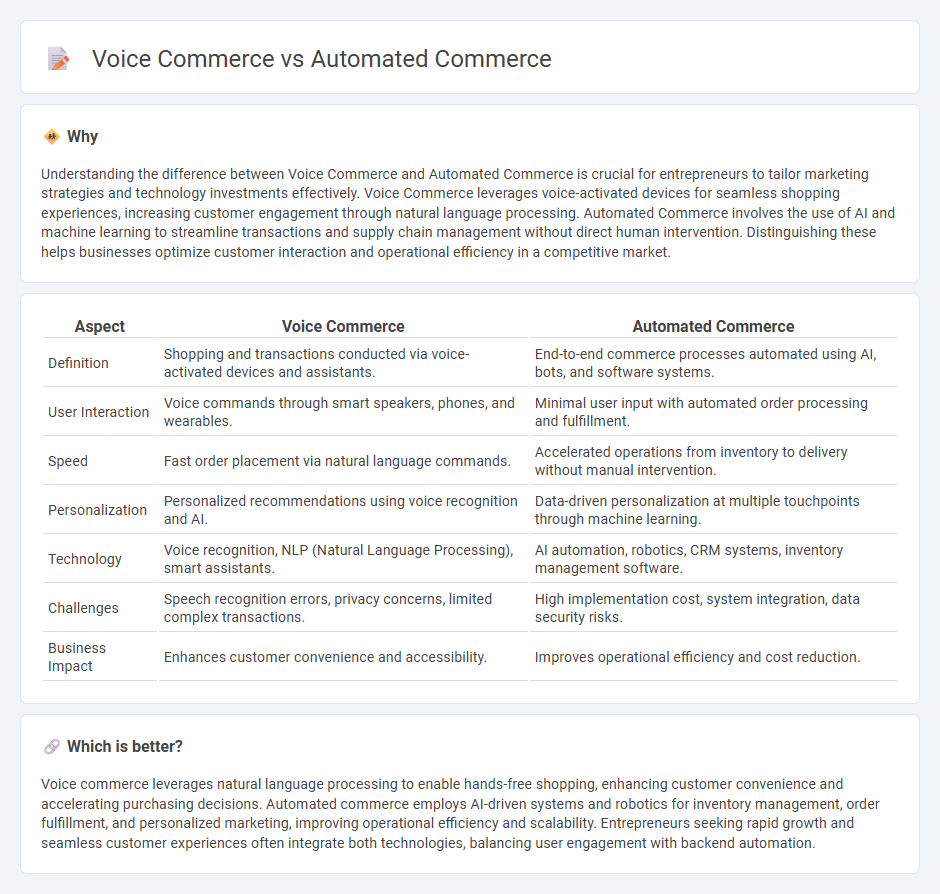
Voice commerce leverages voice recognition technology to enable customers to make purchases through smart speakers and voice-activated devices, streamlining the shopping experience. Automated commerce employs AI-driven systems and robotic processes to handle order fulfillment, inventory management, and customer service, enhancing operational efficiency. Discover how these innovations are revolutionizing entrepreneurship and transforming retail dynamics.
Why it is important
Understanding the difference between Voice Commerce and Automated Commerce is crucial for entrepreneurs to tailor marketing strategies and technology investments effectively. Voice Commerce leverages voice-activated devices for seamless shopping experiences, increasing customer engagement through natural language processing. Automated Commerce involves the use of AI and machine learning to streamline transactions and supply chain management without direct human intervention. Distinguishing these helps businesses optimize customer interaction and operational efficiency in a competitive market.
Comparison Table
| Aspect | Voice Commerce | Automated Commerce |
|---|---|---|
| Definition | Shopping and transactions conducted via voice-activated devices and assistants. | End-to-end commerce processes automated using AI, bots, and software systems. |
| User Interaction | Voice commands through smart speakers, phones, and wearables. | Minimal user input with automated order processing and fulfillment. |
| Speed | Fast order placement via natural language commands. | Accelerated operations from inventory to delivery without manual intervention. |
| Personalization | Personalized recommendations using voice recognition and AI. | Data-driven personalization at multiple touchpoints through machine learning. |
| Technology | Voice recognition, NLP (Natural Language Processing), smart assistants. | AI automation, robotics, CRM systems, inventory management software. |
| Challenges | Speech recognition errors, privacy concerns, limited complex transactions. | High implementation cost, system integration, data security risks. |
| Business Impact | Enhances customer convenience and accessibility. | Improves operational efficiency and cost reduction. |
Which is better?
Voice commerce leverages natural language processing to enable hands-free shopping, enhancing customer convenience and accelerating purchasing decisions. Automated commerce employs AI-driven systems and robotics for inventory management, order fulfillment, and personalized marketing, improving operational efficiency and scalability. Entrepreneurs seeking rapid growth and seamless customer experiences often integrate both technologies, balancing user engagement with backend automation.
Connection
Voice commerce leverages voice recognition technology to enable consumers to make purchases using smart speakers or voice assistants, streamlining the buying process. Automated commerce integrates AI-driven systems to manage inventory, pricing, and customer interactions without human intervention. Both technologies enhance entrepreneurial ventures by creating seamless, efficient, and scalable sales channels that optimize user experience and operational productivity.
Key Terms
Artificial Intelligence
Artificial Intelligence drives both automated commerce and voice commerce by enhancing customer interaction and streamlining transactions through machine learning algorithms and natural language processing. Automated commerce leverages AI to predict shopping behavior and automate supply chain management, while voice commerce uses AI-driven voice recognition to enable seamless, hands-free purchasing experiences. Explore the latest AI advancements transforming these e-commerce modalities to stay ahead in the digital market.
Natural Language Processing
Automated commerce leverages AI-driven systems to streamline transactions across digital platforms, enhancing efficiency through data analytics and personalized recommendations. Voice commerce relies heavily on Natural Language Processing (NLP) to interpret and respond to spoken commands, enabling seamless, hands-free shopping experiences via virtual assistants like Alexa and Google Assistant. Explore how advancements in NLP are transforming customer interactions and driving innovation in the future of commerce.
Omnichannel Integration
Automated commerce leverages AI-driven systems to streamline transactions across digital platforms, while voice commerce utilizes voice recognition technology for hands-free shopping experiences. Omnichannel integration ensures seamless interactions by unifying automated and voice commerce channels, enhancing customer engagement and operational efficiency. Explore how blending these technologies drives the future of retail innovation.
Source and External Links
Top 5 eCommerce Automation Companies in 2024 [With ... - GritGlobal - Automated commerce uses software to streamline repetitive online retail tasks like order processing, inventory management, and customer segmentation, allowing businesses to scale efficiently and enhance customer experience.
Automated Ecommerce Operations: Automate More and Work Less - Ecommerce automation improves efficiency by automating purchasing notifications, predictive purchasing, order validation, inventory updates, and real-time order tracking without manual input.
Ecommerce Automation: Definition & Tips | Salesforce US - Ecommerce automation automates repetitive tasks triggered by predefined rules such as sending confirmations, reengaging abandoned carts, inventory refills, pricing updates, fraud screening, and customer communication for improving operational efficiency and customer satisfaction.
 dowidth.com
dowidth.com